|
[Front Page] [Features] [Departments] [Society Home] [Subscribe]

Short Cuts
Short items of interest about Australian plants selected from the many newsletters and journals published by member Societies of ASGAP.......
Short Cuts in this issue:
 Alyogyne huegelii Alyogyne huegelii- An attractive Australian member of the Hibiscus family.
 One of the Toughest One of the Toughest- Lomandra multiflora deserves to be better known as a hardy and reliable species for many areas
 Death of a Eucalypt Death of a Eucalypt- A cautionary tale for suburban gardeners
 Growing Rainforest Vines Growing Rainforest Vines- Ones to choose - ones to avoid!
 Candles in the Wind Candles in the Wind- Although often taken for granted, Banksia ericifolia is an outstanding plant in the bush and in the garden
 To Prune or not to Prune? To Prune or not to Prune?- ...that is indeed the question!

Alyogyne huegelii
Australian members of the Hibiscus family are not cultivated as much as they deserve. The genus Alyogyne is an exception and has a lot to offer, as Monika Herrmann describes......
Although foliage and texture are the dominant features and structure of our gardens throughout the year, Spring brings about the splendour of flowering colour, plants vying to show off their beauty..and don't the birds and insects love it! Purples and deep blues are a favourite in my garden and recently I spotted a new splash of dark purple as my Alyogyne huegelii is beginning to show its colours.
Alyogyne huegelii is named after Karl von Hugel, a 19th century Austrian botanist. Alyogyne comes from the Greek, alytos, united or undivided and gyne, which is more familiar meaning woman or female, in reference to the undivided style. There are about four species endemic in Australia and all were previously included in Hibiscus but can be recognised by the undivided style. The genus is popular in cultivation as the plants are very fast growing, hardy and flower profusely for a long time. For gardeners who have mixed gardens, these plants combine easily with exotic species.
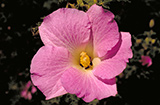 |
Alyogyne huegelii is widespread in dry summer areas from South Australia to south western Australia.
Select the thumbnail image or highlighted name for a higher resolution image (19k).
|
It's a medium to tall spreading shrub with hairy and often roughened branches, the bright green leaves deeply lobed into 3-5 segments (palmate like a maple or divided like a hand). The plant becomes covered in masses of hibiscus-like flowers which are large and stunning, 7-10cm across in single, delicate flowers growing from the leaf axils. Colour varies - you can choose from white, yellow, mauve or deep purple - and the plant flowers from October to March, often for most of the year. The late summer-autumn period is often the least floriferous time so this plant is most useful. Height can be between 1-2.5m by 1-3m and the plant needs to be given a hard prune after flowering as it can become straggly without shaping. For such a delicate looking flower it is surprising that it is frost hardy and very adaptable to a range of soils from light to heavy and can cope with semi-shade or full sun. Dry conditions are also tolerated; its only drawback when looking for a site for this plant, is that it does not take kindly to strong winds.
Apparently, the white flowering form has a more sprawling growth habit and brighter green leaves. A.huegelii 'Moora' has large overlapping petals. The plant grows naturally from the Mt Lofty Ranges in South Australia to south-western Western Australia.
Alyogyne can be propagated from seed or can be struck easily from cuttings.
The other three species are: A.cuneiformis, a small to medium shrub, A.hakeifolia, a similar sized shrub and A.pinoniana, the Sand Hibiscus, a medium to tall sprawling shrub. I have not seen these plants myself.
Reference: R.Elliot and David Jones, Encyclopaedia of Australian Plants, Vol.1
From the newsletter of the Foothills District Group of the Australian Plants Society (Victoria), October 2000.
[ Return to Index
]

One of the Toughest?
Finding plants that are tough, hardy and attractive is not always easy. Tim Hayes reckons he's found a good one!
In a newsletter from one of the other ASGAP groups I read an article on Lomandra longifolia which emphasised how tough a plant it was. I have no reason to doubt the truth of what was in the article but it set me thinking about one of the same genus that is common around here: Lomandra multiflora. The strap leaves on this species do not reach the length that leaves do in L.Iongifolia; they often twist and curl back towards the ground.
When the location for our house was prepared. a site was flattened and rolled hard. L.multiflora has managed to germinate and grow well in the hard clay. Several of this species have grown and have survived things which would destroy less hardy plants even in the two years since we moved in.
Trucks and cars have driven over them. The kids have cycled over them and they have been walked on. They have survived wet and dry times not to mention hot and cold times. Last September I put up a small shadehouse kit that I had bought some years ago, the larger shadehouse having satisfied my requirements previously. I selected a flat site on grass and put it up. While most of the grass has shrivelled up, not the Lomandra multiflora that is growing under cover, despite the lack of moisture and the very high temperatures.
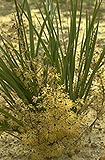 |
The flowers of Lomandra multiflora are very prominent and are seen in spring. The plant is dioecious with male and female flowers on separate plants.
Select the thumbnail image or highlighted name for a higher resolution image (47k).
|
L.multiflora flowers in spring. There are male and female plants which can be distinguished in flower. The flowers spikes are yellow/strawish in colour and can be quite visible. One plant down among the trees had a flower spike that I measured at 47 centimetres - about three times as tall as the plant.
Despite the numbers of this species. either more male than female plants are produced or seed set is difficult. There were relatively few plants from which it was possible to collect seed from mid-summer but I was able to collect from other locations. According to one source, seed germinates readily so I will be trying some later on. L multiflora is not as spiky as L.Iongifolia and as the leaves generally curl back, does not attack you in the legs. For flat clayey soils, it could be hard to beat for longevity and toughness.
From the newsletter of the Southern Tablelands Group of the Australian Plants Society (NSW), March 1999.
[ Return to Index
]

Death of a Eucalypt
Sometimes simple actions can lead top long term problems. Barbara Daly has a cautionary tale for suburban gardeners, learnt from bitter experience.....
About 22 years ago, my acreage was a mere eight years young when I acquired this very small plant, supposedly a low-growing wattle, from land cleared out beyond Rossi.
It was planted about 3.6 metres away from the north-east corner in front of my house and about 4.5 metres from the corner of the house of my neighbour, who I assured of the future size of the plant, i.e. a small wattle. It grew slowly and healthily but no flowers. Being so attractive why worry about identification until it does flower!
A few more years on it had revealed itself as a tall, shapely eucalypt producing lovely scented clusters of cream feathery flowers every year. By this time a variety of prostantheras, leptospermums, and callistemons shared its garden, with Crowea exalata, Leptospermum 'Julie Anne', and others lining the drive. And all plants lived and flowered harmoniously - really nice.
But Euc, realising it was on a good thing, grew and grew and grew.
It spread its limbs over the driveway, protected the house from the summer sun, and did likewise next door. The birds regarded it as good for perching, shelter, and food supply. Insects didn't damage it much and branches didn't fall or die. A tree which enjoyed living and one to be proud of.
Years passed. A passing forester reminded me (a few times) that it was a large forest tree, a brown barrel - Eucalyptus fastigata - and that it hadn't stopped growing! Worse still, I had witnessed fallen trees in the Australian National Botanic Gardens caused by gale force winds. Suburban trees too had lost limbs or fallen. What if one should fall on my neighbour's property, although to date no branches had fallen from the less beautiful street trees, E.nicholli, which had numerous dead limbs. This uncertainty had to stop - the euc had to go.
|
| "My sad beautiful tree now covered the nature strip - shredded and in open-fire sized logs. " |
|
Eventually lumberjacks arrived complete with ropes, pulleys, and ladders, One bloke swung from sawn-off branch to the next branch, another directed the branches to earth, while yet another fed the severed branches into an enormous guzzling machine.
Only the once mighty, now stark, trunk remained. How will it 'go' without damaging the dense undergrowth? 'Never fear', they said, for right on cue was the largest cherry picker ever which swung the increasingly large trunk sections over the tops of the banksias, hakeas and others and on to the nature strip.
My sad beautiful tree now covered the nature strip - shredded and in open-fire sized logs. The latter, within 24 hours, had been confiscated by boggle-eyed muscular scavengers; the former wheelbarrowed to the four corners of this garden. My beautiful tree is no more. The driveway hakea is under the summer sun, the understorey is more dense because of more sunshine and needs constant pruning and two trees have taken its place - Acacia podalyriifolia, Queensland silver wattle, and Banksia integrifolia, coastal banksia.
There is a lesson to be learned about the death of this tree. Know your plants before acquiring them (eg. height, width, distance needed from houses, consideration of your neighbour's acreage and suitability for a suburban garden. It will save much heartache, many dollars and, most of all, the life of a tree which enjoyed living. Too many trees are being removed from our cities.
Please consider.
From the journal of the Canberra Region, Society for Growing Australian Plants, September 2000.
[ Return to Index
]

Growing Rainforest Vines
Vines are a very important part of the rainforest. Garry Sankowsky suggests that anyone who is growing a rainforest plot should consider the possibility of adding some climbers.
It is not practical to grow vines over young trees when starting a rainforest garden from scratch, because they will quickly smother everything. Here's a couple of possible solutions.
In my garden I had a number of large eucalypts (bloodwoods and ironbarks) and I used these as "vine trees". The soil was prepared in the usual way (with a D4 dozer) and mulched. Then the rainforest trees and shrubs were planted. A space of about 3 metres was left around each existing eucalypt for the planting of the vines. Stakes were driven into the ground and bailing twine was run from these to the lower branches of the eucalypts. Galvanised nails were driven into the branches to attach the twine. The twine enables the vines to climb into the branches of the trees, without twining round the trunk. On average, I planted about 50 vines at the base of each tree.
Another method which I used for some species was to plant them at the base of a pole. I used treated pine poles so they would not rot. For this method I planted only one species per pole. The vines climb the pole then fall back and climb over themselves to form a tangled clump. If they run along the ground they can easily be cut off.
Almost all vines need sun, so even if they are planted in the shade at the base of a tree they will climb to the top and spread out in the canopy.
Beware! Many vines can get very large and have the potential to cover at least a hectare of garden. Overall, vines in the Convolvulaceae family are the worst offenders. I collected a small Convolvulus vine from the Larva Plains area which usually only grows to about 3 metres long and dies back each year. In cultivation at Tandara it grew to a huge vine with numerous 50-metre long stems in a couple of years. It killed an ironbark tree by shading it from the light and has now been brought under control. At least with vines you can saw them off at the base to bring them into line!
Some other species to be wary of are: Faradaya splendida (glory vine), Entada phaseoloides (matchbox bean), Mucuna gigantea (Burny bean), Trophis scandens, Neosepicaea jucunda (Jucunda vine) and Omphalea queenslandica.
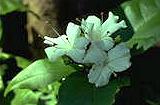 |
|
Two to avoid unless space is not restricted.
Glory vine Faradaya splendida (top) and Trophis scandens (bottom).
Select the thumbnail image or highlighted name for a higher resolution image (19k and 50k).
Photos: Jan Sked and Ian Sutton
|
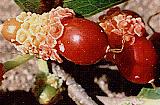 |
Some worthwhile vines to plant are Aristolochia tagala (for the Cairns Birdwing Butterfly), Tecomanthe sp. "Roaring Meg Creek" (huge pink flowers), Hoya sp. (perfumed flowers), and Pandorea jasminoides (large pink flowers, ideal on a fence).
Remember, almost all vines need their foliage to be in the sun to flower, so if you are building a trellis to grow them on, make sure there is enough light.
From SGAP Queensland's "Bulletin", December 2000.
[ Return to Index
]

Candles in the Wind
Sometimes spectacular and hardy plants are so common in gardens that they are overlooked. Paul Davies reckons that the heath-leaved banksia is in this category.
A recent bleak and blustery winter day found me squelching along a fire trial in Muogomarra Nature Reserve north of Berowra, a outer suburb of Sydney. On this particular day the trail wasn't even suitable for ducks, but not having ventured along this track for a few weeks I was curious to see what was coming into flower.
To my initial disappointment there wasn't a lot happening on the inflorescence front, but the smells of the wet heath were wonderful. Amongst the greenery, made vivid by the overcast day, I started to notice the intense burnt orange of banksia candles. A wind keening over the ridgetop brought the banksias to life with the candles dancing amongst the foliage. As you may haste guessed, the candles belonged to Banksia ericifolia, so incredibly common around the Hornsby district that we tend to take it for granted. On this occasion however, it was almost a rediscovery of a long lost species, and one's appreciation for such a beautiful plant was rekindled.
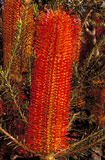 |
Banksia ericifolia is truly an outstanding plant, with its delicate light green foliage contrasting with both the surrounding bush and, its own red-orange flower spikes.
Select the thumbnail image or highlighted name for a higher resolution image (51k).
|
B.ericifolia is one of a handful of banksias in the Sydney region whose flowers open from the top of the cone down. The inflorescence itself is a dense spike about 10 to 20cm long and 5 to 7cm wide. When released the style of each individual flower on the cone remains distinctly hooked. Flowers spikes appear from about March onwards to September or later, and the plant bears flowers relatively early in its growth (a definite plus for this species from a Banksia ericifolia gardener's point of view). Once fertilised, the cone usually develops a number of woody fruits, which normally remain closed until the plant dies. At this time, the valves on the pod open to release two winged seeds separated by a woody plate.
In the bush, B.ericifolia is 4 to 7m high depending on its situation, exposure and the soil it is growing in. It is found throughout the Sydney Region from the coast up to the Blue Mountains, mainly on soils derived from Hawkesbury sandstone. It is a common component of heaths and shrub-woodlands in both well-drained and damp locations.
Whilst the books say this species does best in sunny spots in the garden, my specimen is doing well in quite pronounced shade and in unbelievably poor soil. Its bushy spreading habit makes this banksia an ideal screening plant to hide the less attractive aspects of your yard, including old paling fences, compost heaps, etc.. Truly a plant deserving of a place in everyone's garden.
From the August 1996 issue of "Blandfordia", newsletter of the North Shore Group of the Australian Plants Society (NSW).
[ Return to Index
]

To Prune or not to Prune?
It's not rocket science but many people are confused when it comes to pruning Australian plants. Norm McCarthy has the "good oil"....
To many of us pruning may represent a frightening thought, or an unnecessary chore. Too many of us disregard this most obvious and needed procedure to invigorate, sustain and regenerate constant healthy growth in the majority of our plants.
Believe me, they prosper and grow better with regular attention. As a plant grows, tip pruning will create multiple growth and keep your plant on the move by keeping it compact, strong and vigorous.
Ultimately this will reap its reward with greater production of flowers.
Most of the more widely grown shrubs in gardens are easy to treat in this manner. Callistemon, Melaleuca, Kunzea, Calothamnus, Grevillea, Prostanthera, Westringia and Eremophila, to name a few, respond to this treatment. With other genera be careful and seek advice, as some plants require special attention, or prefer to be left alone. Perhaps the growth of some do not require a great deal of pruning, but we can soon find out by judicious enquires. Really, it is mostly common sense and not being too heavy at the start with your secateurs. However, experience is a great teacher and once you learn it will stick with you for all time.

While we endeavour to emulate nature as much as possible, garden-wise a great deal is artificial. Bush fires, drought and flood determined the situation in the wild but nowadays, of course, we in our wisdom have changed all that. Nature was the natural leveller and so the pruner. Our gardens are protected from much of the vagaries of nature and perhaps suffer accordingly. We exclude our plants from these natural phenomena by providing extra drainage, watering and protection. Raised beds, the use of some pesticides, fungicides and growth inducers, all contribute to a changed environment and circumstance, different to the natural situation.
Perhaps in small allotments, in suburban areas, with gardening space restricted, we should consider the economics of pruning. By restricting the size and spread of our plants, we can indulge in more variation and numbers in a given area and thus create greater interest than with fewer, larger, unpruned subjects.
Once a good programme of economic pruning has been established, we should consider pruning annually at least as a routine and, with faster growing species as often as deemed necessary, to further encourage new growth. A little and often contains the fast growers and enables us to have more goodies to that given area of valuable estate.
Even if your plants are overgrown, leggy and unproductive, it could be advantageous to attempt rehabilitation in some form, even if it incurs some losses ultimately.
Remember, in your garden, space is valuable, so performance and excellence are paramount. Also, good husbandry by pruning generally extends a plant's life span immeasurably. This is your bonus for good gardening practice.
A wise procedure is to trim your plants carefully. Any plant should be approached on its individual merits and pruned accordingly. A little thought beforehand can make a deal of difference afterwards. Don't hack back haphazardly - plan the operation. Remember, you can't glue it back on again once you cut it off.
Clean cuts with sharp tools, with as little damage as possible, will prevent fungal problems and die back. If possible, don't prune back beyond a node with some new growth evident.
A well pruned shrub is a healthy one and a promise for the future.
From "Native Plants for New South Wales", newsletter of the Australian Plants Society (NSW).
[ Return to Index
]

[Front Page] [Features] [Departments] [Society Home] [Subscribe]
Australian Plants online - March 2001
Association of Societies for Growing Australian Plants
|